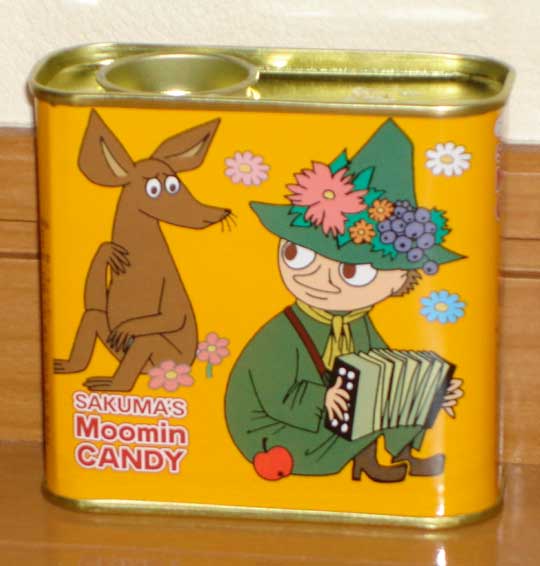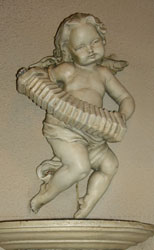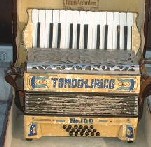JAPANESE Version is HERE.
the Diatonic Accordions and Concertinas
Squeeze Boxes
22 Nov,1998This is the English summary of my article which is going to be carried on "Accordion Journal" edited by Mr KANEKO, Mototaka. I hope you succeed in reading my confused English.

|
Snufkin (or "Snus mumrik" in svenska, "Nuuskamuikkunen" in Suomi) is playing the diatonic accordion. He is known and loved widely in Japan. |
|
Sep.23,2007  |
Click the button "die moldau". You can see the founder (me) perform the Anglo-concertina. The Diatonics are coming into Japan again !
The founder playing a one-row diatonic accordion Tombo "Olympic" which was made in Japan in 1930s.
Å@Today, in Japan only piano accordions and some chromatic types are seen on stage of "accordion contests", how ever the Japanese cherished diatonic accordions some decades ago.
Now, squeeze boxes are reviving among the younger generations in Japan.
An old accordion made in Japan
(Tombo LIRICO No.100)
 The earliest accordions were invented in 1820s. All types of them were diatonic types. You must be alert that the meaning of the term "diatonic" is rather different from its original meaning when used in explaining the types of accordions. In the accordions, "diatonic" means "push and pull" type, (i.e. different notes come out when you pull and push the bellow of that instrument).
The earliest accordions were invented in 1820s. All types of them were diatonic types. You must be alert that the meaning of the term "diatonic" is rather different from its original meaning when used in explaining the types of accordions. In the accordions, "diatonic" means "push and pull" type, (i.e. different notes come out when you pull and push the bellow of that instrument).Å@
- bandoneons in tango
- melodeons and concertinas in Irish trad. Most of the Japanese would be confused because Suzuki (it is also renowned as an auto bike maker) products a brand of piano harmonica "MELODEON" which is very popular among Japanese schools and pupils.
- Other unique diatonic accordions are seen in Cajun, Zydeco, Tex-Mex, Alpine, etc.
Ciaran Carson in Ireland wrote in his book "Irish Traditional Music" (1986), the piano accordion is not only unsuitable but also may destroy the Irish trad music, while the melodeon is very suitable to play this genre (This Carson's book was translated into Japanese by Isao Moriyasu who himself is also a musician of Irish traditional music)
|
Accordion Families
Before the World War II ended in 1945, Japan was so poor that only few could buy piano accordions. CLICK HERE
|
There are many types of the diatonic accordions. Their history is longer than that of chromatic types, and they became important parts of ethnic musics in the world.
Although some bass buttons are equipped on the left hand, these squeeze button boxes are basically suitable to play melodies, especially fast passages.
Some Japanese makers such as TOMBO and YAMAHA used to product diatonic accordions some decades ago, but now they do not. In China (including Taiwan) and Korea they still product cheap diatonic accordions which are exported largely and seen commonly at music shops in Japan.
Å@
My Anglo concertina Bastari 40 buttons. Made in Italy. Although this is a kind of "push and pull", this instrument can play melodies and chords at the same time which enable you to play it as a solo instrument.
Concertinas have many types: diatonic and chromatic. 20 buttons, 30, 40, and so on.
In Irish traditional music which is getting popular among the younger Japanese the 30 button diatonic concertina is used most commonly. However I use 40 button Anglo concertina because this instrument enables you to play larger genre of music including classic, Japanese folk songs, and so on. I played this instrument on stage at "Annual 10th Meeting of Accordionists in Tokyo and Surrounding Prefectures" Sep. 1998, and a friend of mine said this awful and small button box is undoubtedly "A free-bass concert accordion invented in 1830s which can be hung on a finger". In reality, you can enjoy playing Smetana's "Die Moldau (Ma Vlast)" by this compact and light instrument.
Regret to say, the concertina always used as a "melody instrument" in ensemble, I feel this is just like playing a piano only with a single hand.
The movement of this music instruments is very unique, so you can see it far more frequently than you may anticipate. A Japanese maker GLICO broadcasts a TV advertisement film for their "Silk Touch Chocolate": a young actress plays a concertina pushing and pulling in the sky. Her performance means this chocolate tastes like a well blew soft cream.
And, in Japan, this instrument was once seen on the hands of a tomato boy sitting on a chimney at night.
Though this instrument sometimes seen in TV, magazines, and live stages in Japan, the audience sometimes takes the concertina for the small bandoneon. In reality, these two instruments are no more the same than a cat and a tigers are.
There are some diatonic accordionists ( or concertina players ) in Japan who teach in their class or record their own compact disc. Mr Eiichi YONEYAMA, Mr and Mrs MORIYASU, Mr Fumio YOSHIDA, Mr Shinichi SAKATA, and so on.
In Japan, a considerable amount of squeeze boxes are seen in the Annual Irish Trad Camp in Takashima town, Shiga prefecture. Some band such as Exile(Osaka) and Estrada(Tokushima Prefecture) also use squeeze boxes on stage.
Ms Maki TAKIYA's "Home Page of the Melodeon and Concertina" is worth viewing because it provides elaborate pixes which would help you understanding these instruments. In 1997, Japanese major TV program broadcasted her squeeze box performance on air and introduced her magnificent homepage.
Å@Japan also has ardent button box players although they are not so many.